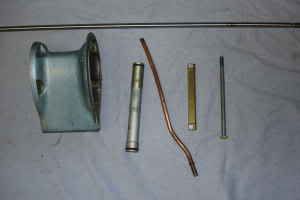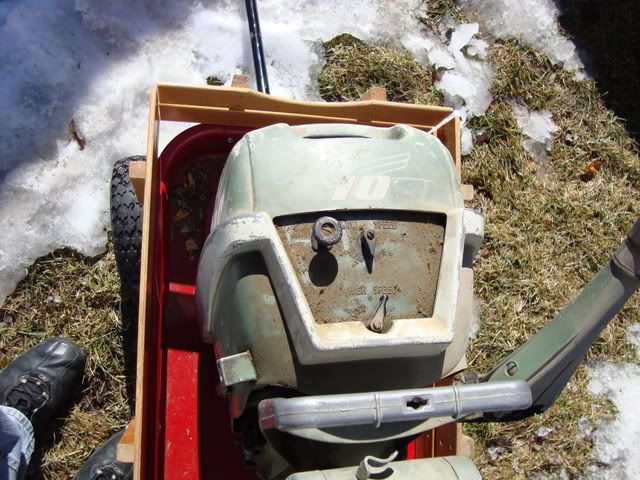Re: Looking for a Vintage Kicker
The newer motors have a place to mount a pulse type fuel pump. This consists of two mounting bosses, with threaded holes to screw mount the pump to them and a third boss, which is simply a drilled hole that provides vacuum/pressure pulses from the inside of the powerhead.
I mention pulse type specifically, because some people try to put electric fuel pumps on outboards, which is a bad idea for a lot of reasons. By sticking with a pulse type pump, you avoid the problems and are able to use commonly availble parts from the OEM, Sierra, Mikuni, etc.
Many of the 50s vintage motors did not use fuel pumps. Instead, they used the two line system, one of which fed pressure from the crankcase into the fuel tank, thereby pressurizing it. That, in turn, forced fuel back to the motor, in order to feed the carburetor. These motors can usually be converted to pulse type pumps (there are different ways to go about this), which eliminates the need for a pressure type fuel tank.
The reason why this is a big deal, is because usable pressure tanks are becoming more and more scarce. They are also relatively small in size, at 5 to 6 gallons, for the most part. If the only thing you use a kicker for is trolling, this might not be that big a deal, but it can be if the motor's function is to provide safety backup, as well. The basic point is that you may need more than 6 gallons to get home, if you are a long way out.
If you have an outboard that either has a fuel pump, or has been converted to one, you have a lot more options in terms of the tanks you use. First, you can buy a plastic tank from iboats, wally world, etc. and you can buy them in a variety of sizes. Another possibility is to install a fuel valve in the boat which allows you to feed the I/O or another engine. With that in mind, you can keep a small tank of premixed fuel in the boat for trolling on the kicker, plus some 2 stroke oil in bottles for mixing into the main tank. Under this scenario, you enjoy the simplicty of the small, separate tank for routine kicker use, but have the ability to add oil to your internal tank(s) if you need to.
Obviously, the latter scenario becomes sort of a pain if you have one, 50 gallon internal tank. If you have a pair of smaller tanks, its not so bad, because you don't have to carry a large quantity of two stroke oil to get the proper mix for the amount of gas available in a given tank.
Look at it this way, if the I/O won't run for some reason, you use the fuel in the small tank to run the kicker. If that amount of gas gets you back to the dock or to a safe place, so much the better, because you don't have to worry about fuel contamination in the internal tank, being the reason why the I/O quit. What I'm getting at here, is that its better to get "in" on the separate engine with a separate fuel supply, if you can. Should that small tank not be sufficient, however, at least you have the option of going to the alternate fuel supply, if you have the extra oil aboard and you have an engine that can suck the fuel out of the other tank and use it.
I'm kind of laughing at myself right now, because I've written a bit of a "book" about all this, but the subject is one that I've thought about a lot. This is true because I boat in a place that you can get 30 -40 miles out into the "middle of nowhere," pretty easily. I have a kicker on my boat, but it isn't for trolling - its for getting me home, in the event that my main outboard becomes damaged or won't run.
???























